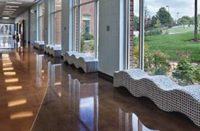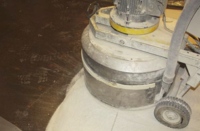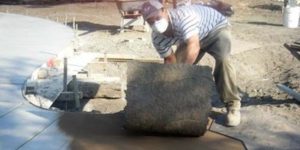Have you ever been to a museum and looked at a beautiful painting? The depth of color, the intricate variations of texture and the captivating lines all combine with the way that the light is reflected and seems to be drawn into the painting.
Imagine what that same painting would look like if it were painted on tree bark or fence boards instead of a high-quality canvas.
The medium (or substrate) that is used in a work of art has a lot of control over the finished product. Polished concrete is no different. You have all seen beautiful pictures of floors that show fantastic color, reflectivity and clarity. A breathtaking array of patterns and designs are shown in Concrete Decor and other magazines all the time. What you don’t see are the close-up shots of poorly finished column block-outs, hand-finished edges at cold pour joints, or the spalled control joints that were cut using a dull saw blade in such a way that the aggregate is ripped out of the slab rather than cut through. Not many people in our industry want to admit that these issues are out there. But your customers will find these issues and expect the flooring contractor to try to fix them.
Unfortunately, on most remodel projects there is not a lot that can be done to control these types of issues, and the repair methods are a topic for a whole different article. (Discussing these potential concerns with your customer ahead of time will greatly help your situation.)

However, on new construction, with good planning and forethought you can take the concrete finish from really bad to pretty good, and this will take your customer’s experience and satisfaction to a whole new level.
Not every project has the controls in place that some of the better national retailers are able to command. On your everyday project, more often than not, the lowest-priced concrete finisher is who ends up with the project. Still, managing the quality of the concrete pour and finish is an integral part of turning out consistently high-quality concrete floors.
In my experience I have found that preventing problems on the front end is much easier than trying to fix them.
The prevention process starts by making sure that the polished concrete contractor is involved as early in the project as possible. I recommend having a preconstruction meeting with the customer, architect, general contractor, concrete finisher, mason and polished concrete contractor. This is not hard to do, as any project of size has meetings with all of these parties in attendance before construction begins. Since the polished concrete subcontractor is ultimately responsible for the finished project, he or she should run this portion of the meeting. All aspects of the concrete placement should be discussed: mix design, curing methods, weather issues and how they can potentially affect the finished product, the specific equipment that will be used to finish the slab, edging techniques, column block-out treatments, flatness and levelness, cure time before any grinding occurs, floor protection during construction (a big one) and anything else that will have a bearing on the final outcome. This is also a good time to discuss maintenance, since all involved parties are in the room together.
One important thing to remember is that if a slab is poorly finished at the beginning, you have the option of choosing to take it out and replace it. If the building is built and at the end of the project you do not like the result, it is impossible to replace the slab properly at that point.

I recommend having specific floor flatness levels and testing built into the specifications. This will help ensure that the polished concrete floor will have consistent aggregate exposure throughout the project. If there are sharp deviations in flatness, this is usually reflected in spot areas of large aggregate exposure.
Edges are also significant because hand-finished concrete is more porous than mechanically troweled concrete is. The most common result of hand-troweled edges is a general white appearance, because the open pores of the concrete do not get polished while the surface does. This problem is especially common along block walls where the concrete is poured to the wall, as opposed to the slab being poured and mechanically finished before the block wall is placed on top of the slab. A block-on-slab wall will have a much more consistent edge.
There are many ways that slabs can be poorly finished, and not all of these have anything to do with the concrete finisher. Nature can play a major role in how a slab finishes out as well. Rain, wind, sunshine and ice can cause issues. It is important to discuss this with the general contractor beforehand. While schedule is always a driving factor, pouring on a risky day can really come back to hurt the finished floor. Sometimes waiting that extra day or pouring a day early can mean all the difference to the finished product.
Remember, prevention is the most important part of helping a concrete finish turn into a great canvas.















